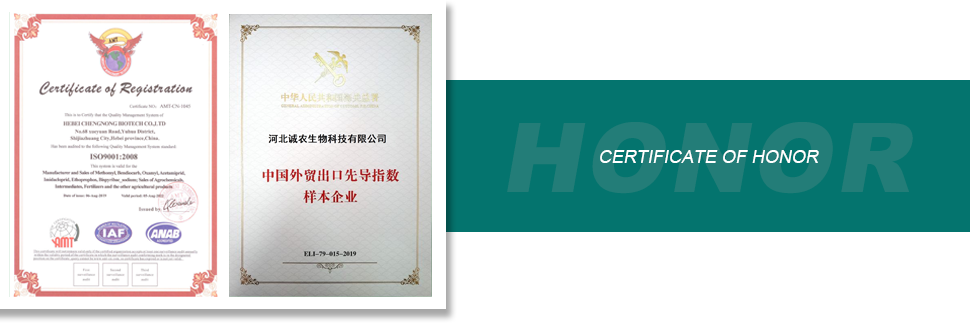
Dec . 04, 2024 16:17 Back to list
pymetrozine 50 wg factory
The Impact of Pymetrozine 50 WG on Agriculture A Comprehensive Overview
Pymetrozine 50 WG (Water-Dispersible Granules) is an insecticide that has garnered significant attention in the agricultural sector due to its efficacy in managing various pests. Originally developed to combat aphids and other sap-sucking insects, Pymetrozine offers a unique mechanism of action which differentiates it from traditional insecticides. This article explores the chemical properties, usage, advantages, and potential environmental impacts of Pymetrozine in modern agriculture.
Chemical Properties and Mechanism of Action
Pymetrozine belongs to a class of insecticides known as pyridine azomethines. Its active ingredient works primarily by interfering with the normal feeding behavior of pests. By inhibiting specific neuronal pathways in insects, Pymetrozine causes them to stop feeding almost immediately after exposure, thereby reducing damage to crops. This neurotoxic effect is particularly effective against aphids, whiteflies, and leafhoppers, making it a preferred choice among farmers dealing with these pests.
Unlike many conventional insecticides, Pymetrozine is classified as a selective insecticide, which means it primarily targets specific pests while exerting minimal effects on beneficial insects. This characteristic is crucial for integrated pest management (IPM) strategies, as it helps preserve the natural predator-prey dynamics essential for maintaining ecosystem balance.
Application and Efficacy
Pymetrozine 50 WG is typically applied through spray methods. Farmers mix the granules with water to create a solution that can be easily distributed using standard agricultural equipment. The timing of application is critical; it is most effective when used at the early stages of pest infestation. For best results, it is recommended to monitor pest populations regularly and apply Pymetrozine as soon as threshold levels are reached.
The efficacy of Pymetrozine has been documented in various studies, demonstrating its capability to significantly reduce pest populations. Many growers have noted visible improvements in crop yield and quality after implementing Pymetrozine treatment. This has made the product a valuable asset in various crop production systems, including vegetables, fruits, and ornamental plants.
Advantages of Pymetrozine
pymetrozine 50 wg factory

One of the major advantages of Pymetrozine is its selective action; it effectively targets harmful pests while minimizing the impact on beneficial insects, such as pollinators and natural enemies of pests. This selectivity helps maintain biodiversity and supports the sustainability of agricultural practices.
Additionally, Pymetrozine has a favorable environmental profile. It is known for its relatively low toxicity to mammals, birds, and aquatic life when used according to label directions. This aspect is particularly important in an era where environmental stewardship is increasingly prioritized by farmers and consumers alike.
Furthermore, the mode of action of Pymetrozine helps in managing pest resistance. When used as part of a rotational strategy with other insecticides that have different modes of action, it can slow down the development of resistance in pest populations, ensuring long-term effectiveness and sustainability.
Potential Environmental Impacts
Despite its advantages, concerns have been raised regarding the environmental impacts of Pymetrozine. Like many pesticides, improper application or over-reliance can lead to negative consequences such as potential runoff into water bodies, which may affect aquatic ecosystems. Additionally, while Pymetrozine is selective, it is still vital to consider the impact on non-target insect populations. Consequently, integrated pest management strategies should be employed to mitigate these risks.
For optimal results, farmers are encouraged to adhere closely to label instructions, including dosages and application timings. Education on responsible use and the significance of monitoring pest populations are key aspects of successful application.
Conclusion
In conclusion, Pymetrozine 50 WG represents a significant advancement in pest management within the agricultural sector. Its unique mechanism of action, combined with its environmental benefits and selective targeting, positions it as a powerful tool for farmers worldwide. However, like all pesticides, it requires responsible use and integration into broader pest management practices to maximize benefits while minimizing risks. As agriculture continues to evolve, products like Pymetrozine may play a critical role in not only protecting crops but also promoting sustainable farming practices for future generations.
-
Emamectin Benzoate: AI-Optimized Pest Control Solution
NewsAug.01,2025
-
Best Abamectin 95% | Top Pesticide for Crop Protection
NewsJul.31,2025
-
Insecticide Spirotetramat 11% + Thiacloprid 11% SC at Good Price
NewsJul.30,2025
-
Best Abamectin SDS - Premium Quality & Reliable Safety Data
NewsJul.29,2025
-
Agrochemicals Pesticides Solutions for Sustainable Farming
NewsJul.29,2025
-
High-Quality Tebuconazole Fungicide for Crop Protection at Best Price
NewsJul.29,2025
